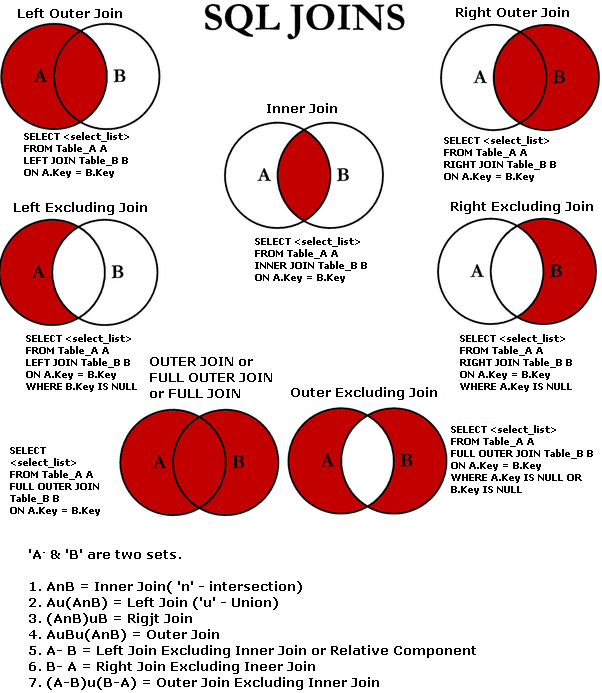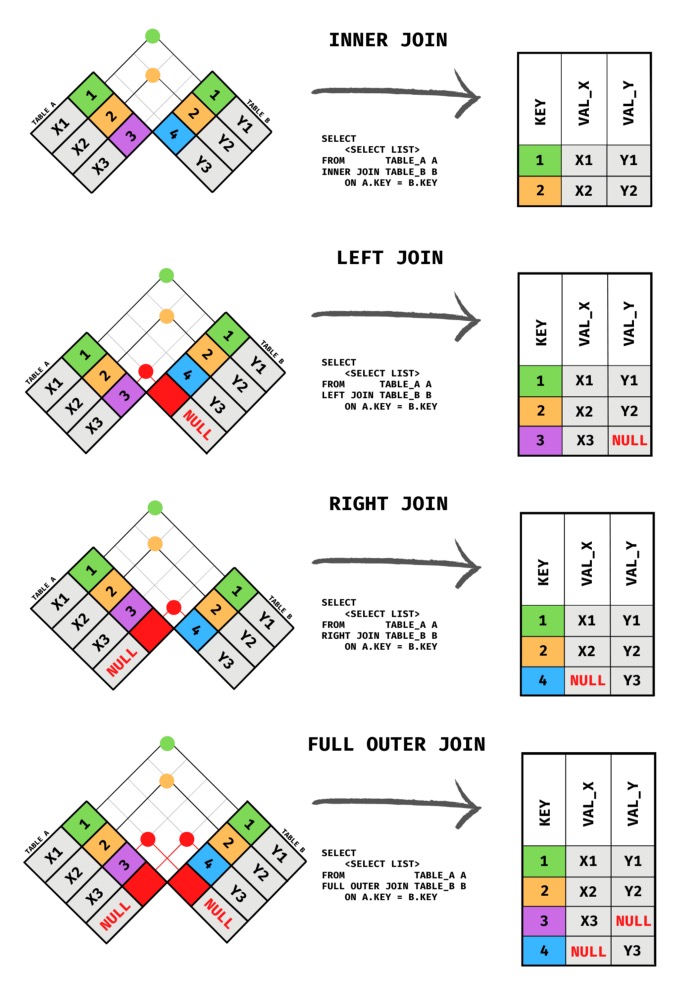SQL study notes#
Basic data manipulation with SQL#
SQL clause order:
FROM --> WHERE --> GROUP BY --> HAVING --> ORDER BY --> SELECTSQL evaluates these clauses in the order: FROM, WHERE, GROUP BY, HAVING, and finally, SELECT. Therefore, each clause receives the filtered results of the previous filter. It would look like this:
SELECT(HAVING(GROUP BY(WHERE(FROM...))))
Create new/modify existing variables
String functions
UPPER()&LOWER()REPLACE(var, pattern, replacement)CONCAT(var1, connection symbol, var2)SUBSTR(var, start_index, length): OracleSUBSTRING(var, start_index, length): MySqlLEN()LTRIM(),RTRIM(), &TRIM(): removing empty space in leading, trailing or bothTRIM(leading/trailing/both, char to be trimed FROM var): to remove specific char from a variableLEFT(str, length),RIGHT(): selecte certain length of string from left/rightPOSITION(substring IN string): return a numeric value, which is the index counted from left where the substring appears first in the stringConditioning
CASE WHEN ... THEN ... ELSE ... END AS new_var_name
Date functions
DATEDD: add one year to an existing dateTO_DATE: convertrs a string into dateDATEDIFF: find the difference b/t two given datesDATEPART: get year, month, or date from the date variableDAY: get day of the month for the given dateCURRENT_TIMESTAMP: get the date and time (time stamp)
Using aggregate functions (COUNT, AVG, SUM, MIN, MAX)
usually used with
GROUP BYNULL value is elimiated in all thse functions, except for
COUNT(*)(COUNT(var)still excludes NULL records)
Apply conditions with
WHEREuse
BETWEEN ... AND...to select obs with value with a range of a variable (inclusive)Using regular expression with
LIKE%: any string of 0 or more character
_(under score): any single character;
[]: any single character with the specificed range e.g. [a-f] <=> [abcdef]
[^]: any single character not within the specified range
Apply conditions using aggregated varaible/value with
HAVING: be clear about the differnce vsWHEREConverting data types
CAST(column_name AS integer)orcolumn_name::integer: convert to integer
Update SQL table
UPDATE table_name SET column1 = value1, column2 = value2, ... WHERE condition;
Advanced SQL tips#
Joining tables#

Filtering with “join” operations:
using
ANDafterONclause: filtering happens before joiningusing
WHEREafterONcaluse: filtering happens after joining
Another way to visualize SQL joins: You Should Use This to Visualize SQL Joins Instead of Venn Diagrams

“Cross join”: performs cross product b/t 2 tables: it connects each row in the left table with each row in the right table
Stacking tables#
UNIONoperator: to stack one dataset on top of the otherSELECT var1, var2, var3 as var3_new FROM table1 UNION SELECT var1, var2, var4 as var3_new FROM table2
If there are same rows from two tables, only one unique row will be shown; or to use
UNION ALLto keep duplicates; The opposite isUNION DISTINCTTwo tables must have same # of cols
Columns must have same data types in the same order
Create a view of the data table[1]:#
security of the data, giving access to only the variables included in the view table
CREATE VIEW table_name AS SELECT var1, var2, var3 FROM table;
Subquery#
innter query/nested query: to perform operation in several steps
subquery need to have an alias
EXAMPLE CODE NEEDED
Window functions#
performs a calculation across a set of table rows that are somehow related to the current row
Example
Aggregate_fun(var) OVER (PARTITION BY var1 ORDER BY var2 ORDER BY var3 ROWS BETWEEN 1 PRECEDING AND CURRENT ROW) AS new_Var
This doesn’t cause rows to be grouped into a single output row as done in the aggreated functions
Three (optional) components:
PARTITION BY: divides the rows of the table into different groups
ORDER BY: defines an ordering with each partition.
The final (window) clause: defining the window frame: defines the set of rows used in each calculation. e.g.
ROWS BETWEEN 1 PRECEDING AND CURRENT ROW- the previous row and the current row.ROWS BETWEEN 3 PRECEDING AND 1 FOLLOWING- the 3 previous rows, the current row, and the following row.ROWS BETWEEN UNBOUNDED PRECEDING AND UNBOUNDED FOLLOWING- all rows in the partition.
Three types of analytic functions[2]
Analytic aggretate functions
Analytic navigation functions
FIRST_VALUE()/LAST_VALUE(): returns the first/last value in the inputNTILE(): determine the percentiles of a give value in a variableLAG() & LEAD():LAGpulls record(s) from previous andLEADpulls from following rows
Analytic numbering functions
ROW_NUMBER(): show row # across the OVER & ORDER BY varRANK(): similar toROW_NUMBER()but will give same rank if value for ORDER BY variable is the sameDENSE_RANK(): differently fromRANK(), it won’t skip rank number if there are more than one obs. records with same value share the same rank
Defining a window alias: a convenient way to use several window functions that use the same window:
WINDOW window_name AS (PARTITION BY var1 ORDER BY var2)
this should come after
WHEREclauseCan’t include a window function in a GROUP BY clause
Nested data#
SQL data can also include a column with multiple fields in it; those fields are nested inside of this column and the nested column has type
STRUCT(or typeRECORD)To query a column with nested data, we need to identify each field in the context of the column that contains it:
C.Name: referes to theNamefield in theCcolumn.
Repeated data#
When an ID contains multiple records in another table, and we want to put the multiple records into one column and we say this conlumn contains repeated data.
Each entry in a repeated field is an ARRAY, or an ordered list of (zero or more) values with the same datatype.
When querying repeated data, we need to put the name of the column containing the repeated data inside an
UNNEST()function.UNNEST(Column) AS var_name; This essentially flattens the repeated data (which is then appended to the right side of the table) so that we have one element on each row.
Nested and repeated data#
A combination of nest and repeat in a column
When reading the values, we need UNNEST and use
C.Nameto read individual field
Pivoting data in SQL (TBA)#
Miscellaneous tips#
IS NULL: check if it’s missing valueJOINis equivalent toINNTER JOINCOALESCE(): select teh first non NULL value in a listUse
EXPLAINat the beginning of the program, which will roughly show the complex of the programPerformance tuning SQL queries
Table size: try to use
LIMIT XXto limit the lines to showJoins: make joins less complicated
We refer to the structure of a table as its schema (something like
str()in R).
Resrouces to learn and practice SQL#
5 Advanced SQL Concepts You Should Know in 2022: for some examples
